 Let’s continue our tour of Hemphill Street (see Part 1) south from the Burlington Northern railroad tracks at the 2400 block.
Let’s continue our tour of Hemphill Street (see Part 1) south from the Burlington Northern railroad tracks at the 2400 block.
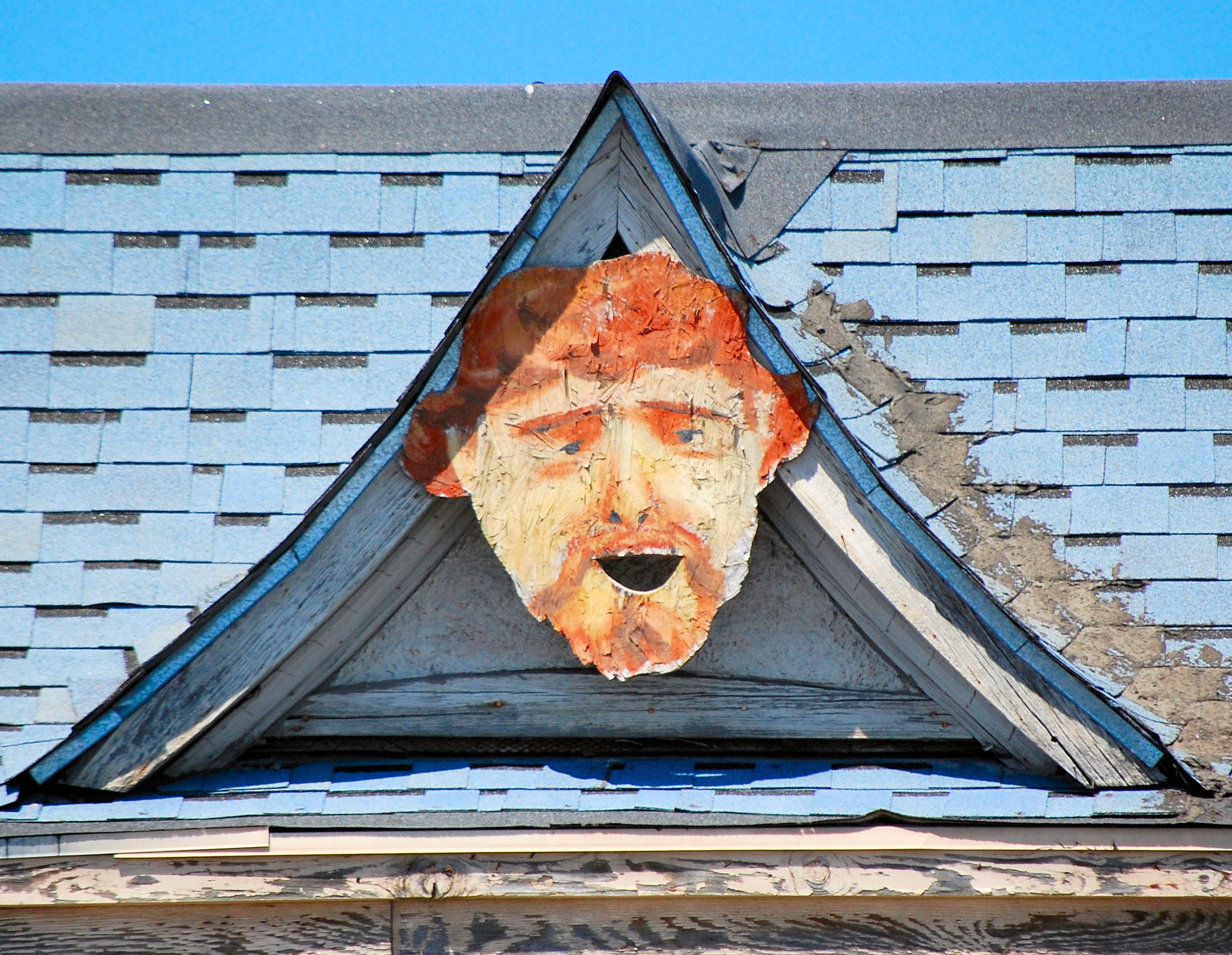 Just south of the tracks at 2500 Hemphill is a modest commercial building of indeterminant age that has housed retail businesses such as a barber shop, an adult bookstore, a piano store, and a liquor store. And these guys. The automotive world has Manny, Moe, and Jack. The entertainment world has Larry, Curly, and Moe. Hemphill Street has the dormer dwellers. (But last time I looked, these three guys were AWOL.)
Just south of the tracks at 2500 Hemphill is a modest commercial building of indeterminant age that has housed retail businesses such as a barber shop, an adult bookstore, a piano store, and a liquor store. And these guys. The automotive world has Manny, Moe, and Jack. The entertainment world has Larry, Curly, and Moe. Hemphill Street has the dormer dwellers. (But last time I looked, these three guys were AWOL.)
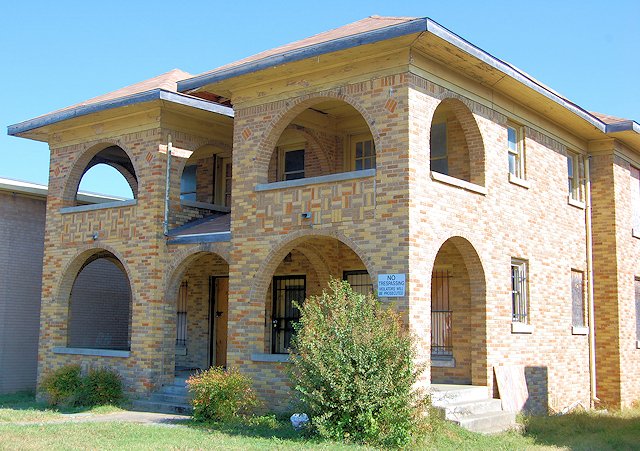
 The buildings across the street from each other at 2709 Hemphill and 2710 Hemphill (1929) feature arches.
The buildings across the street from each other at 2709 Hemphill and 2710 Hemphill (1929) feature arches.
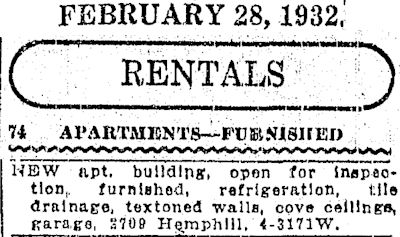 Tarrant Appraisal District says 2709 Hemphill was built in 1925, but the ad indicates the building was new in 1932.
Tarrant Appraisal District says 2709 Hemphill was built in 1925, but the ad indicates the building was new in 1932.
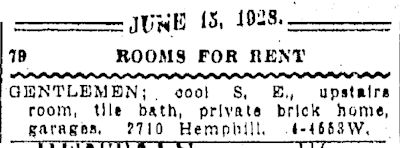 Again, TAD says 2910 Hemphill was built in 1929, but the ad indicates that it was a private residence with a room to rent in 1928.
Again, TAD says 2910 Hemphill was built in 1929, but the ad indicates that it was a private residence with a room to rent in 1928.
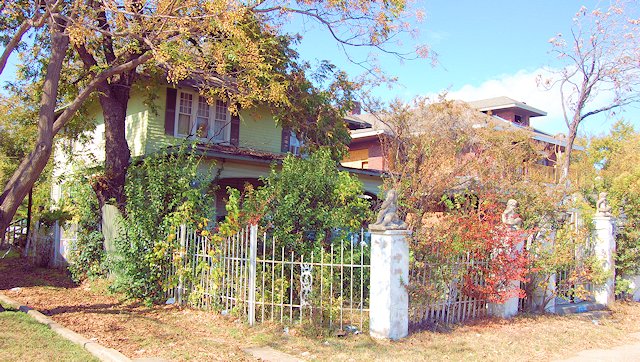
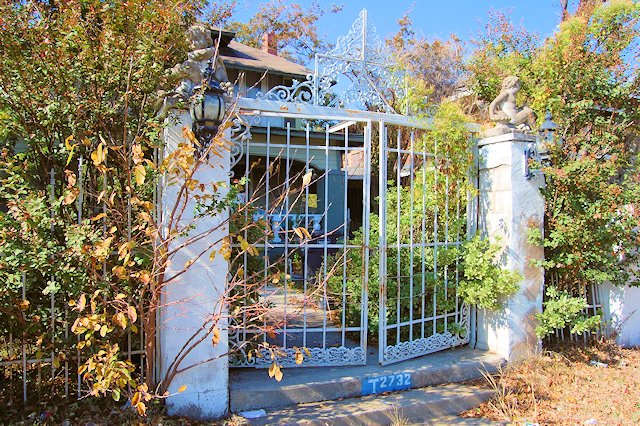 The house at 2732 Hemphill (1916) hides behind a screen of shrubbery and a fence of iron and brick.
The house at 2732 Hemphill (1916) hides behind a screen of shrubbery and a fence of iron and brick.
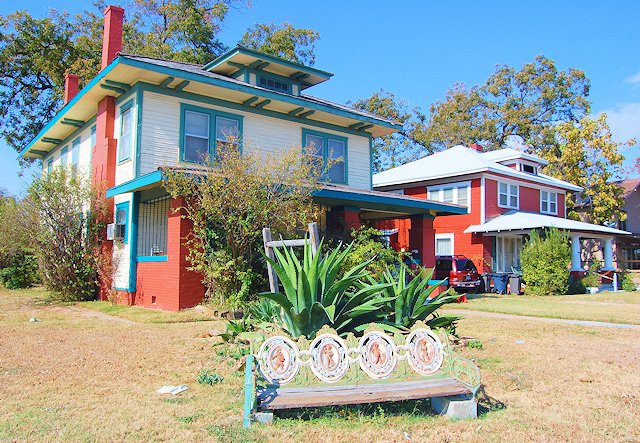 The houses at 2740 and 2744 Hemphill were built in 1918.
The houses at 2740 and 2744 Hemphill were built in 1918.
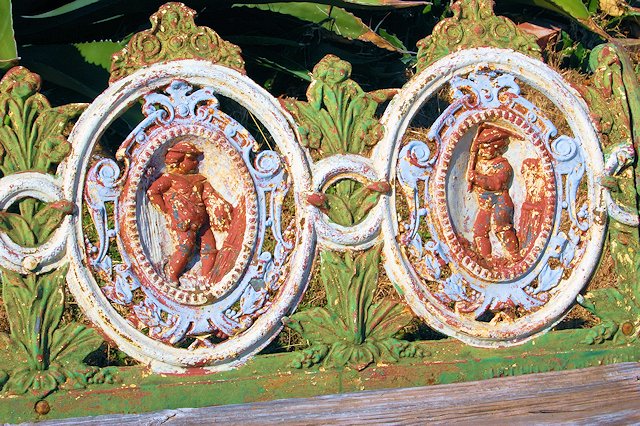 Detail of the wood-and-iron bench in front of 2744 Hemphill.
Detail of the wood-and-iron bench in front of 2744 Hemphill.
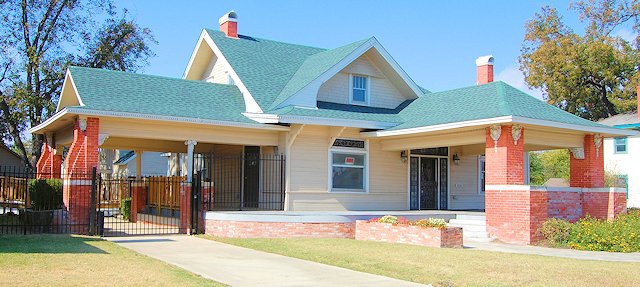
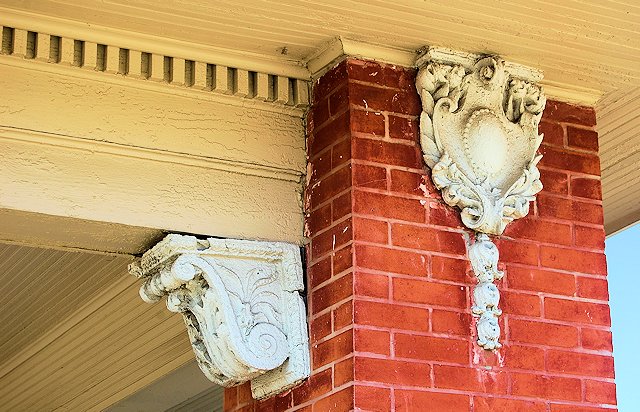
 The house (1910) at 2800 Hemphill is the former home of school board president George C. Clarke, for whom the nearby elementary school (1914) on Shaw Street is named. Clarke also developed real estate, including Hemphill Heights and Hubbard Highlands additions and, with the Shaw brothers in 1907, Shaw Heights and Shaw-Clarke additions.
The house (1910) at 2800 Hemphill is the former home of school board president George C. Clarke, for whom the nearby elementary school (1914) on Shaw Street is named. Clarke also developed real estate, including Hemphill Heights and Hubbard Highlands additions and, with the Shaw brothers in 1907, Shaw Heights and Shaw-Clarke additions.
 Next door, the house at 2808 Hemphill was built in 1919. Today it houses the Fort Worth Panic Room.
Next door, the house at 2808 Hemphill was built in 1919. Today it houses the Fort Worth Panic Room.

 The Hamilton Apartments at 2837 Hemphill were built in 1926.
The Hamilton Apartments at 2837 Hemphill were built in 1926.
 Across the street from the Hamilton Apartments at 2836 Hemphill, this house was built in 1930. Like most of the oldest houses on Hemphill, this one has led many lives: bookstore, senior citizens center, health clinic, beauty school.
Across the street from the Hamilton Apartments at 2836 Hemphill, this house was built in 1930. Like most of the oldest houses on Hemphill, this one has led many lives: bookstore, senior citizens center, health clinic, beauty school.
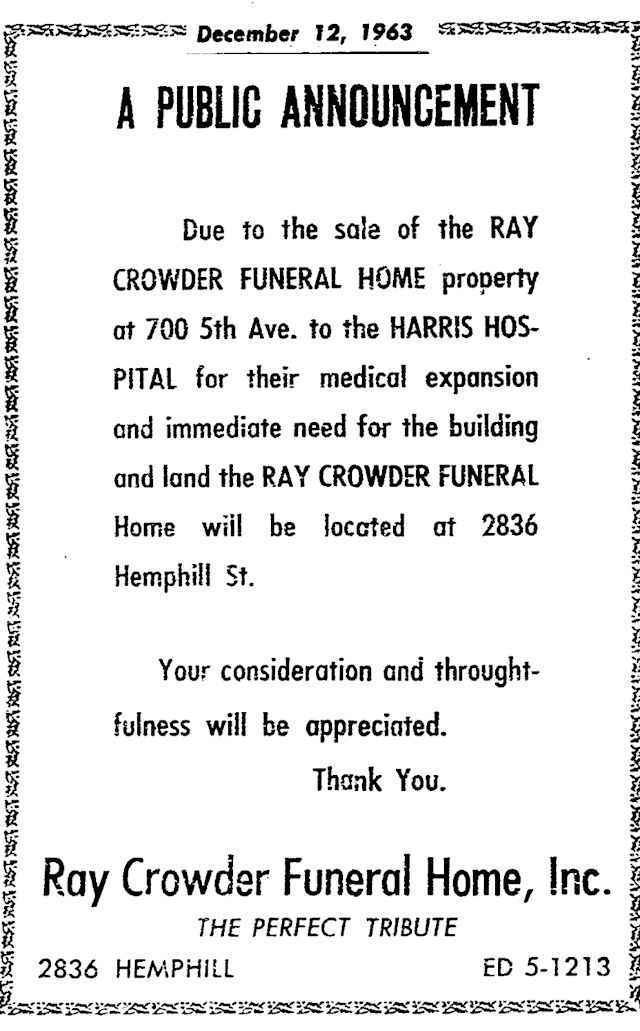 And in 1963, after Ray Crowder Funeral Home sold its 7th Avenue location to Harris Hospital, the funeral home moved to 2836 Hemphill.
And in 1963, after Ray Crowder Funeral Home sold its 7th Avenue location to Harris Hospital, the funeral home moved to 2836 Hemphill.
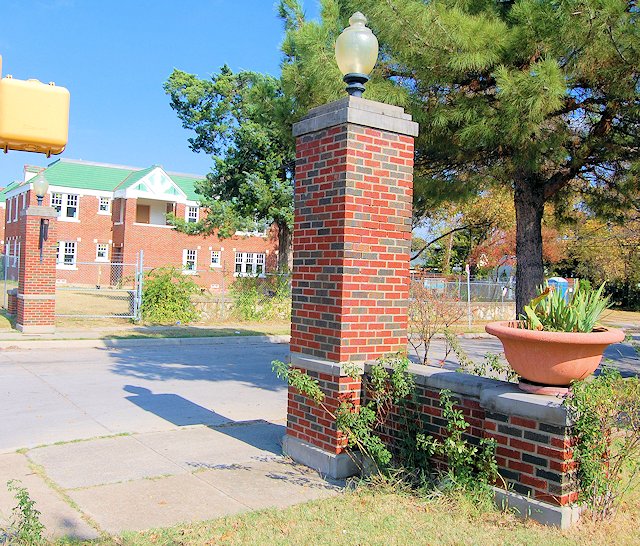
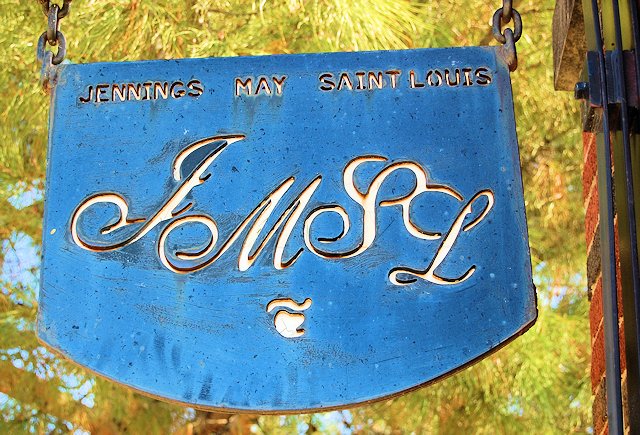 At Lowden Street at the 2900 block of Hemphill stand the entry columns of the Jennings-May-St. Louis neighborhood.
At Lowden Street at the 2900 block of Hemphill stand the entry columns of the Jennings-May-St. Louis neighborhood.
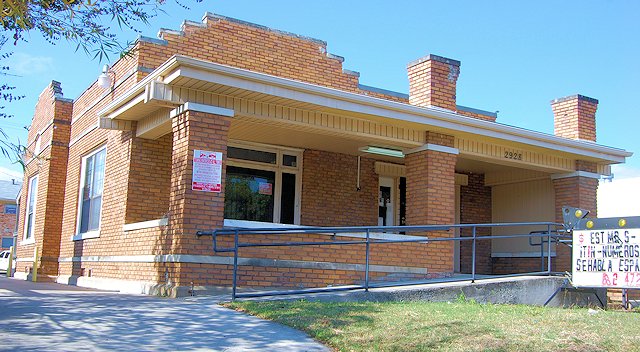 The Bonear House (1924) at 2928 Hemphill has stepped parapets. George H. Bonear was a traveling salesman.
The Bonear House (1924) at 2928 Hemphill has stepped parapets. George H. Bonear was a traveling salesman.
 Some big houses were built on Hemphill in the 1920s. The James House (1924) at 2944 Hemphill has 4,917 square feet. The house was built by Rutherford and Sallie James.
Some big houses were built on Hemphill in the 1920s. The James House (1924) at 2944 Hemphill has 4,917 square feet. The house was built by Rutherford and Sallie James.
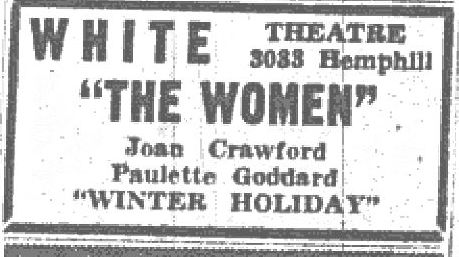
The Berry Theater at 3021 Hemphill originally was the White Theater.
 The house at 3129 Hemphill was built in 1927.
The house at 3129 Hemphill was built in 1927.
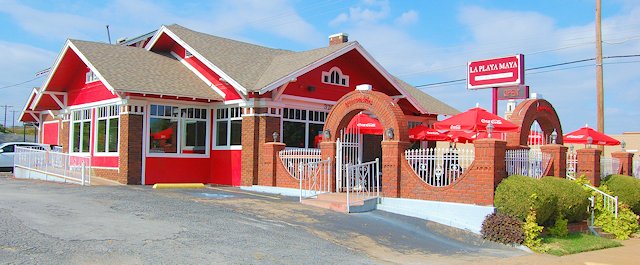
 The house (1926) at 3200 Hemphill that today is La Playa Maya restaurant has 3,658 square feet. It began its career as a residence, then was occupied by an antiques business, a reader-advisor, and a day-care center. Then it was the Aztec Restaurant and, beginning about 1991, La Playa Maya.
The house (1926) at 3200 Hemphill that today is La Playa Maya restaurant has 3,658 square feet. It began its career as a residence, then was occupied by an antiques business, a reader-advisor, and a day-care center. Then it was the Aztec Restaurant and, beginning about 1991, La Playa Maya.
 The Sisters of St. Mary of Namur (founded in Belgium in 1819) built their Academy of Our Lady of Victory (1910, Sanguinet and Staats) at Shaw Street and the 3300 block of Hemphill as a boarding school. Their St. Ignatius Academy (1889, J. J. Kane) downtown became a day school. OLV offered girls a Christian education and had dorm facilities for 150 students. It later offered classes through junior college. It is now a residential complex for Fort Worth’s creative community.
The Sisters of St. Mary of Namur (founded in Belgium in 1819) built their Academy of Our Lady of Victory (1910, Sanguinet and Staats) at Shaw Street and the 3300 block of Hemphill as a boarding school. Their St. Ignatius Academy (1889, J. J. Kane) downtown became a day school. OLV offered girls a Christian education and had dorm facilities for 150 students. It later offered classes through junior college. It is now a residential complex for Fort Worth’s creative community.
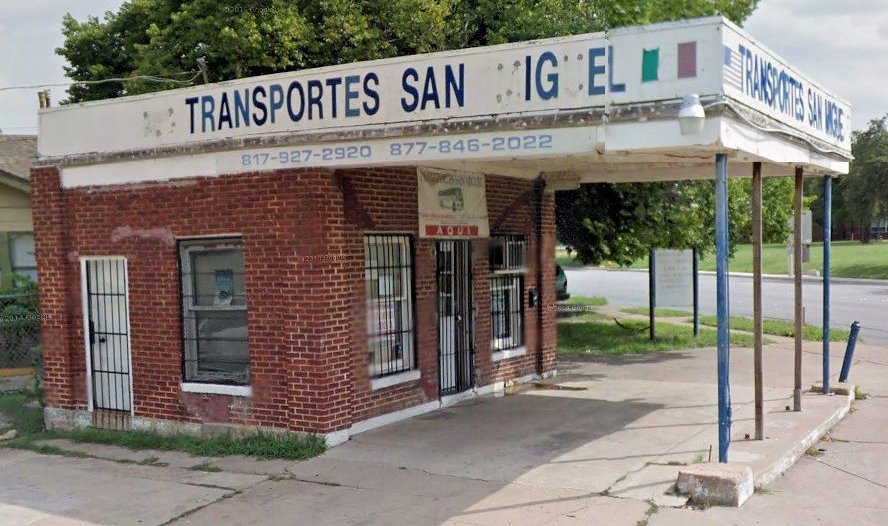 Across the street from OLV at 3301 Hemphill is an office of Transportes San Miguel, a bus service to Mexico.
Across the street from OLV at 3301 Hemphill is an office of Transportes San Miguel, a bus service to Mexico.
 That building (1929) once housed Hemp-Shaw Service Station, so-named because of its location at Hemphill and Shaw streets. Shaw Street is named for the family who operated a large dairy in the area. OLV was built on Shaw land.
That building (1929) once housed Hemp-Shaw Service Station, so-named because of its location at Hemphill and Shaw streets. Shaw Street is named for the family who operated a large dairy in the area. OLV was built on Shaw land.
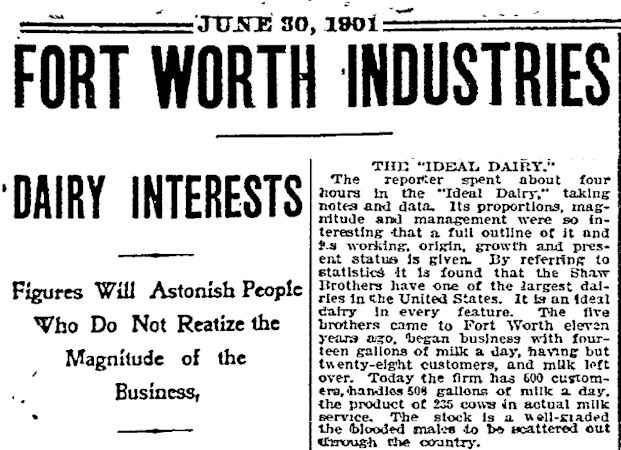

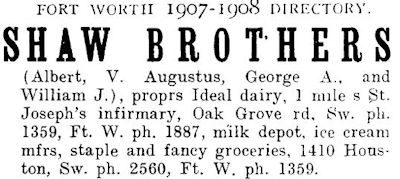
In 1901 the Fort Worth Register published a profile of the dairy industry in Fort Worth, proclaiming that among more than thirty dairies in Fort Worth, Ideal Dairy of the five Shaw brothers was one of the largest in the nation.
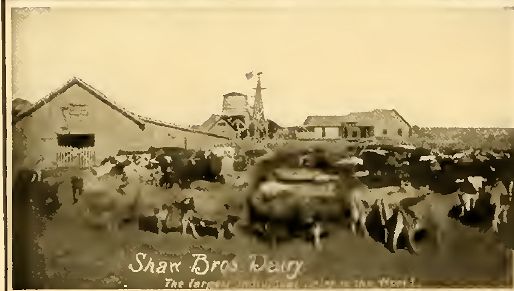 From Greater Fort Worth, 1907.
From Greater Fort Worth, 1907.
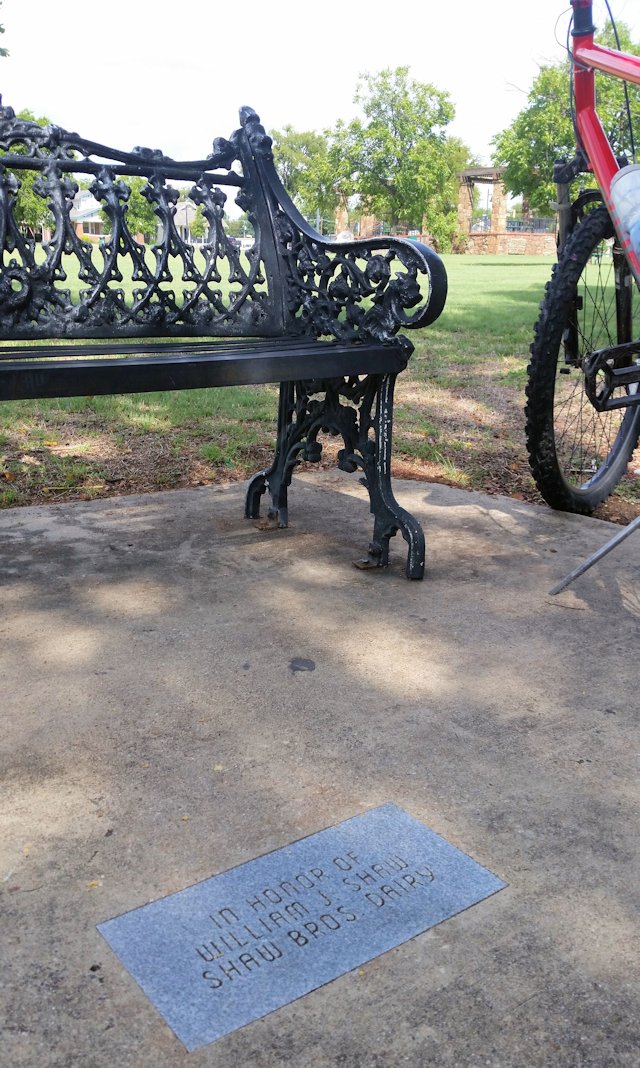 Two blocks west of Hemphill and two blocks north of Shaw Street, a bench in Capps Park is dedicated to Shaw brother William J.
Two blocks west of Hemphill and two blocks north of Shaw Street, a bench in Capps Park is dedicated to Shaw brother William J.
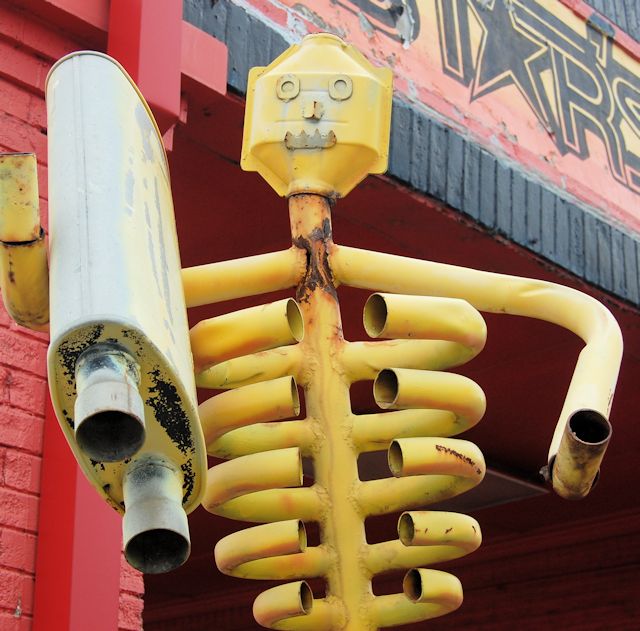 Just south of OLV at Star’s Muffler Shop, this guy looks exhausted.
Just south of OLV at Star’s Muffler Shop, this guy looks exhausted.
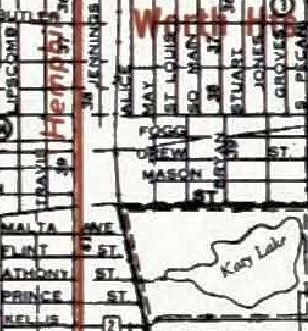 The 4200 block of Hemphill crosses Anthony Street. Under Anthony Street today runs the storm drain tunnel that replaced the creek that once fed Katy Lake.
The 4200 block of Hemphill crosses Anthony Street. Under Anthony Street today runs the storm drain tunnel that replaced the creek that once fed Katy Lake.
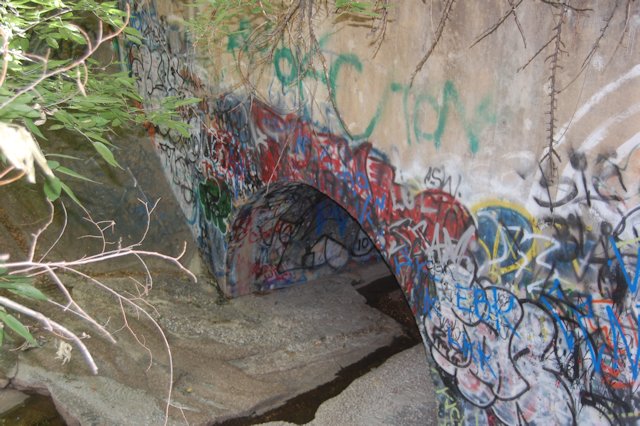
At the east end of Anthony Street a storm drain channel feeds runoff into a tunnel that passes under La Gran Plaza (formerly Seminary South) to an outlet on the east side of the South Freeway and thence to Sycamore Creek.
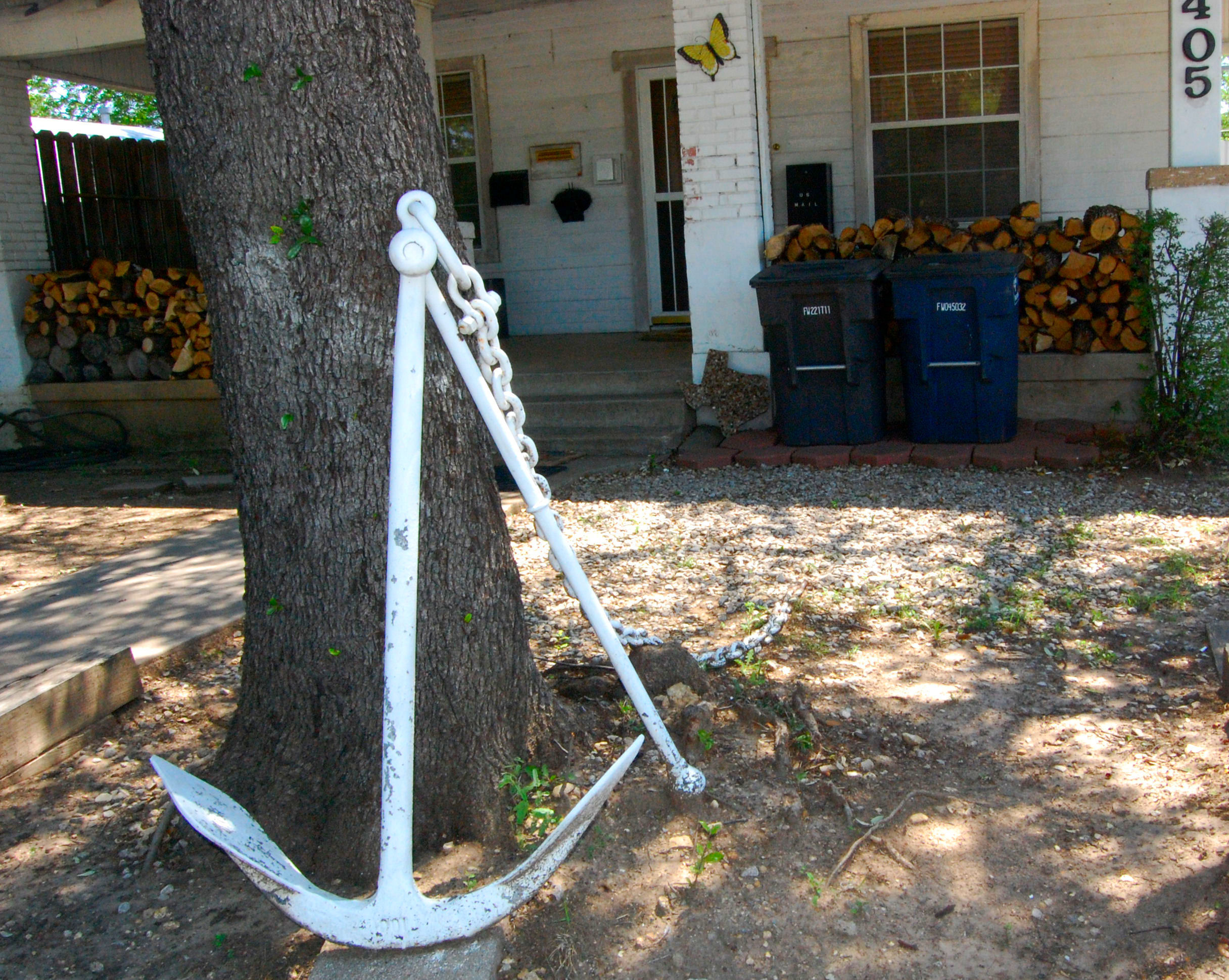
I have long suspected the house (1925) at 4405 Hemphill of being Captain Swabbie‘s home.
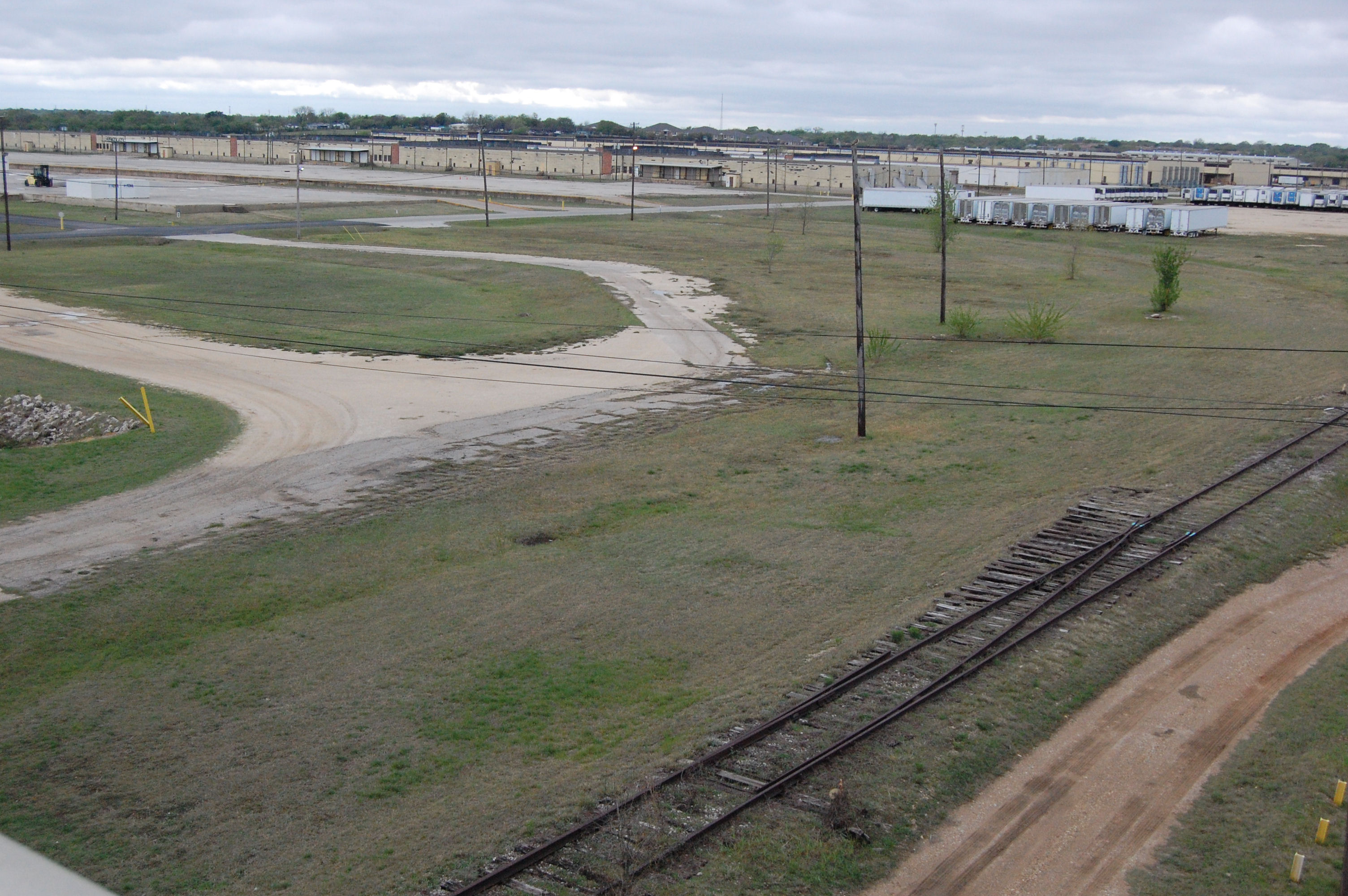 Near the south end of Hemphill at the 4800 block the Quartermaster Depot was built in 1942 as a distribution center for the military during World War II.
Near the south end of Hemphill at the 4800 block the Quartermaster Depot was built in 1942 as a distribution center for the military during World War II.
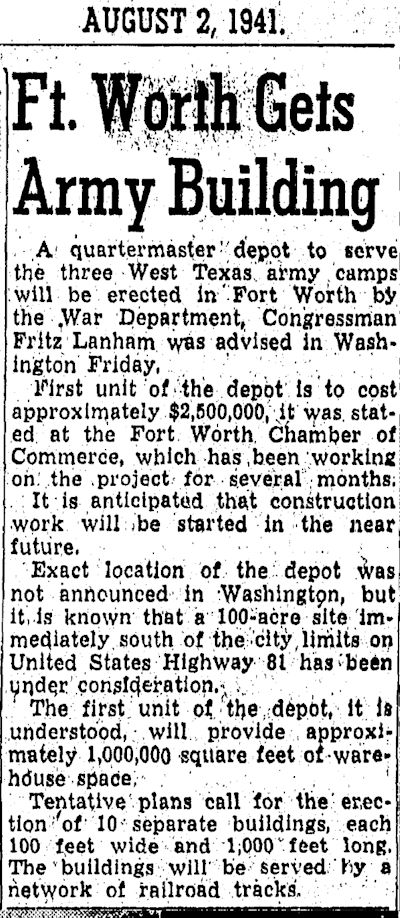 The project was announced in 1941 a few months before Pearl Harbor.
The project was announced in 1941 a few months before Pearl Harbor.
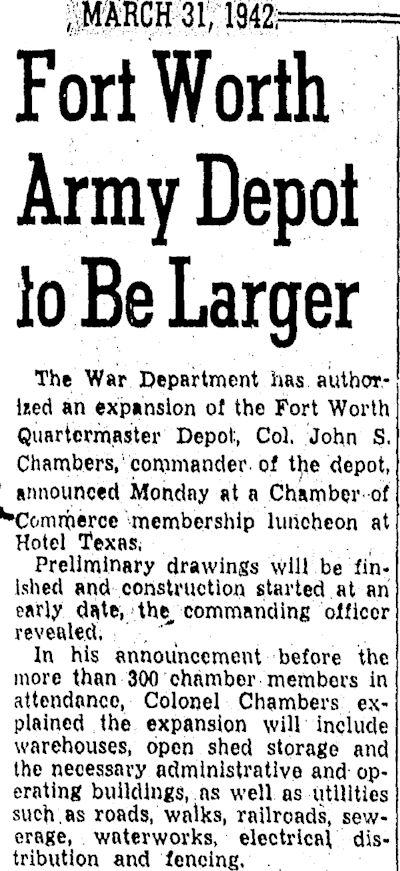 And just a few months after Pearl Harbor, the War Department authorized enlargement of the depot, which was still under construction. The depot opened in May 1942. In addition to its military population, the depot employed more than two thousand civilians.
And just a few months after Pearl Harbor, the War Department authorized enlargement of the depot, which was still under construction. The depot opened in May 1942. In addition to its military population, the depot employed more than two thousand civilians.
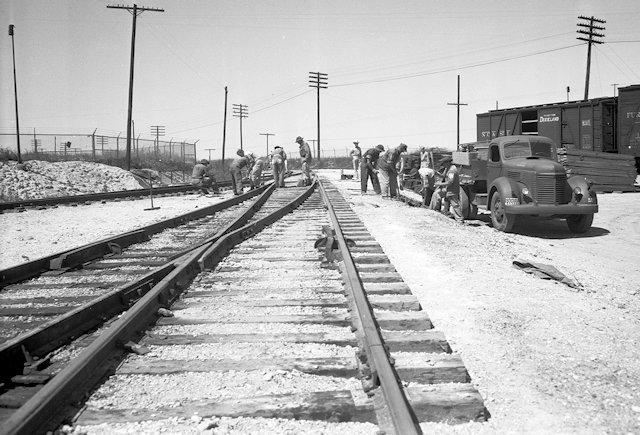 Late in the war the depot housed German and Italian POWs. The above photo shows a detail of German POWs. After the war the depot was used to receive the remains of U.S. soldiers killed overseas in Operation Taps. (Photo from University of Texas at Arlington.)
Late in the war the depot housed German and Italian POWs. The above photo shows a detail of German POWs. After the war the depot was used to receive the remains of U.S. soldiers killed overseas in Operation Taps. (Photo from University of Texas at Arlington.)
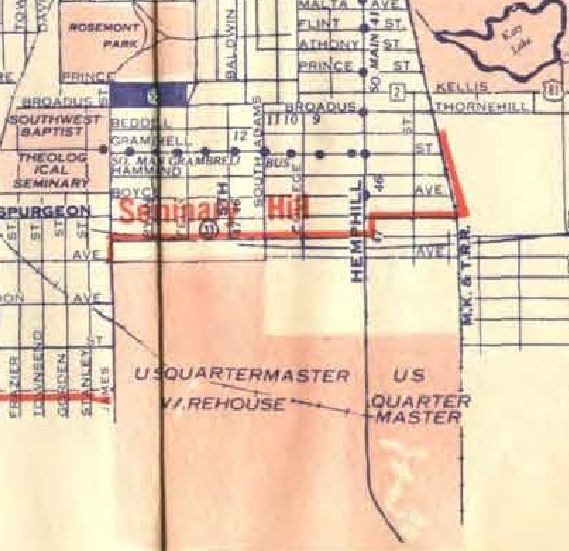 The depot covered a square mile from James Avenue to the Katy track. It was the nation’s third-largest military supply center.
The depot covered a square mile from James Avenue to the Katy track. It was the nation’s third-largest military supply center.
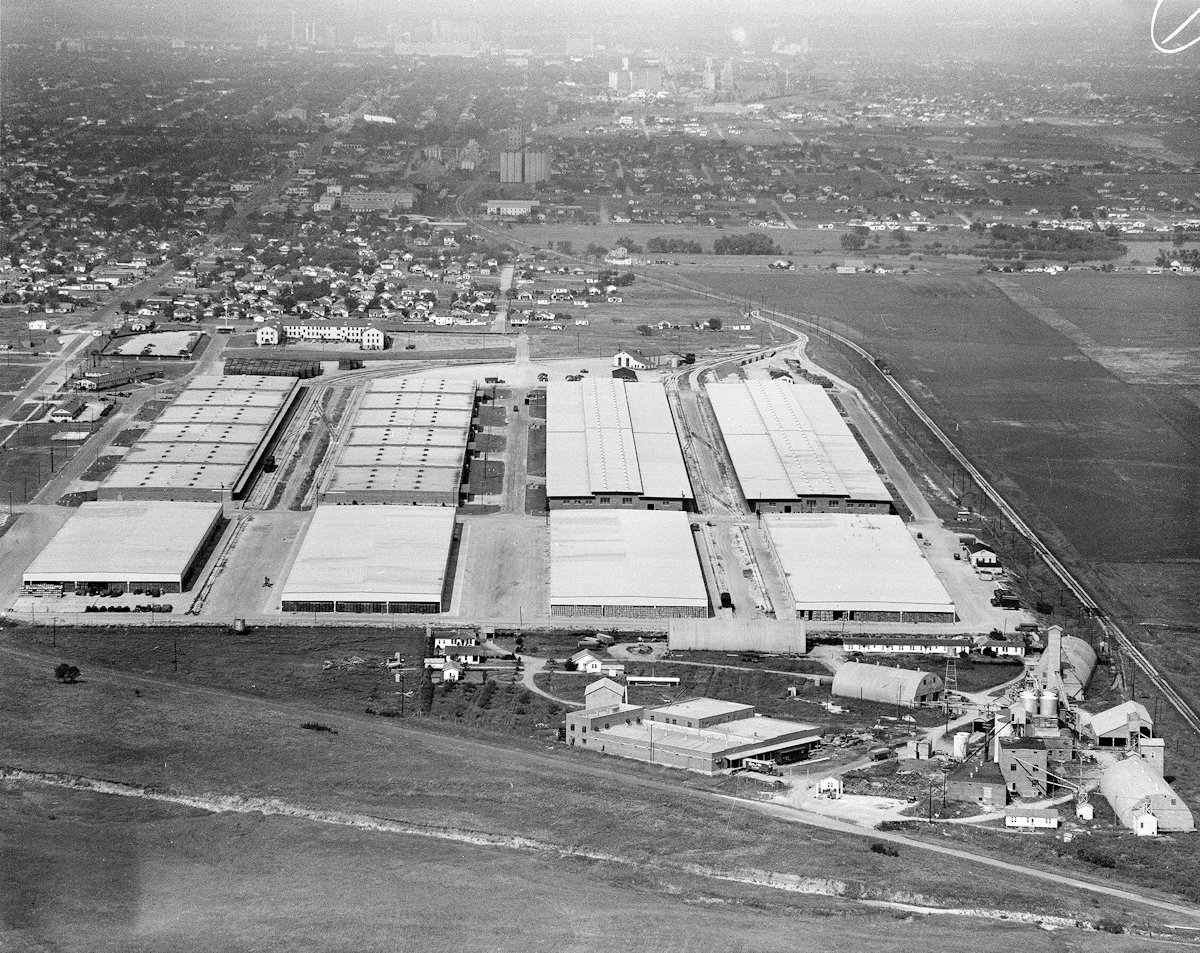
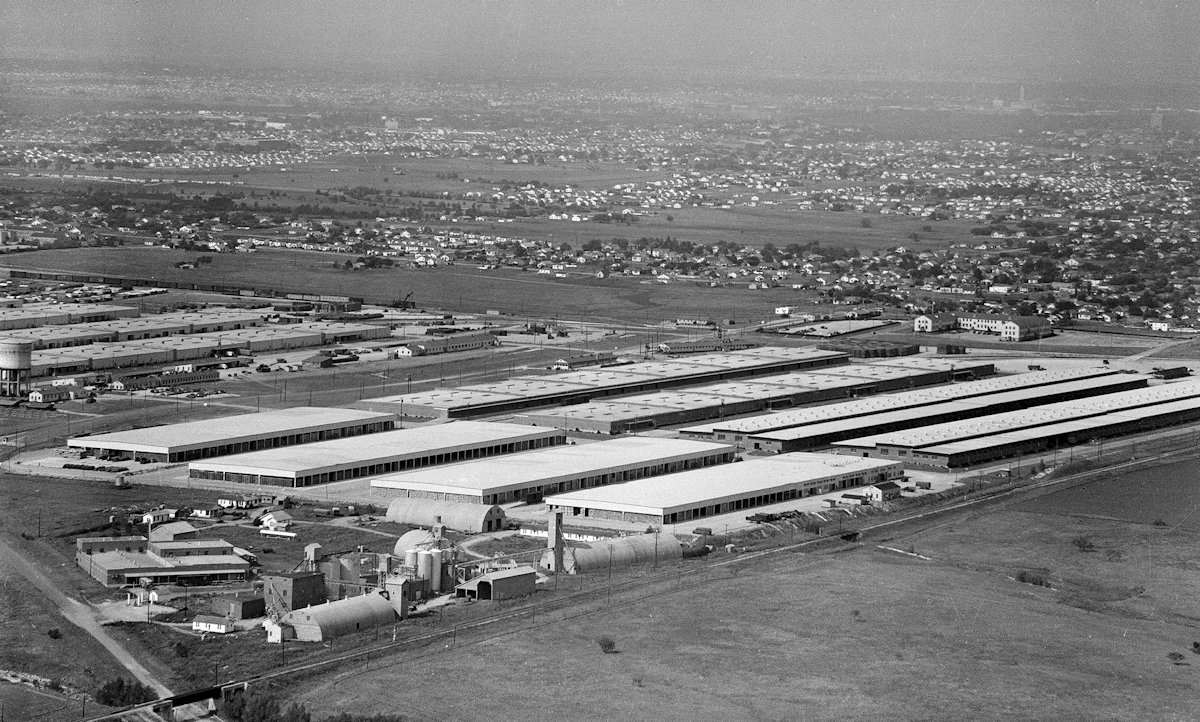 These 1947 aerial photos show part of the depot, mostly east of Hemphill. (Photos from University of Texas at Arlington Library.)
These 1947 aerial photos show part of the depot, mostly east of Hemphill. (Photos from University of Texas at Arlington Library.)

Spurs of the Missouri, Kansas and Texas (Katy) and the Santa Fe railroads were extended to the depot. Fort Worth was chosen as the site of the depot in part because the city was a railroad and meatpacking center. (Photo from University of Texas at Arlington Library.)
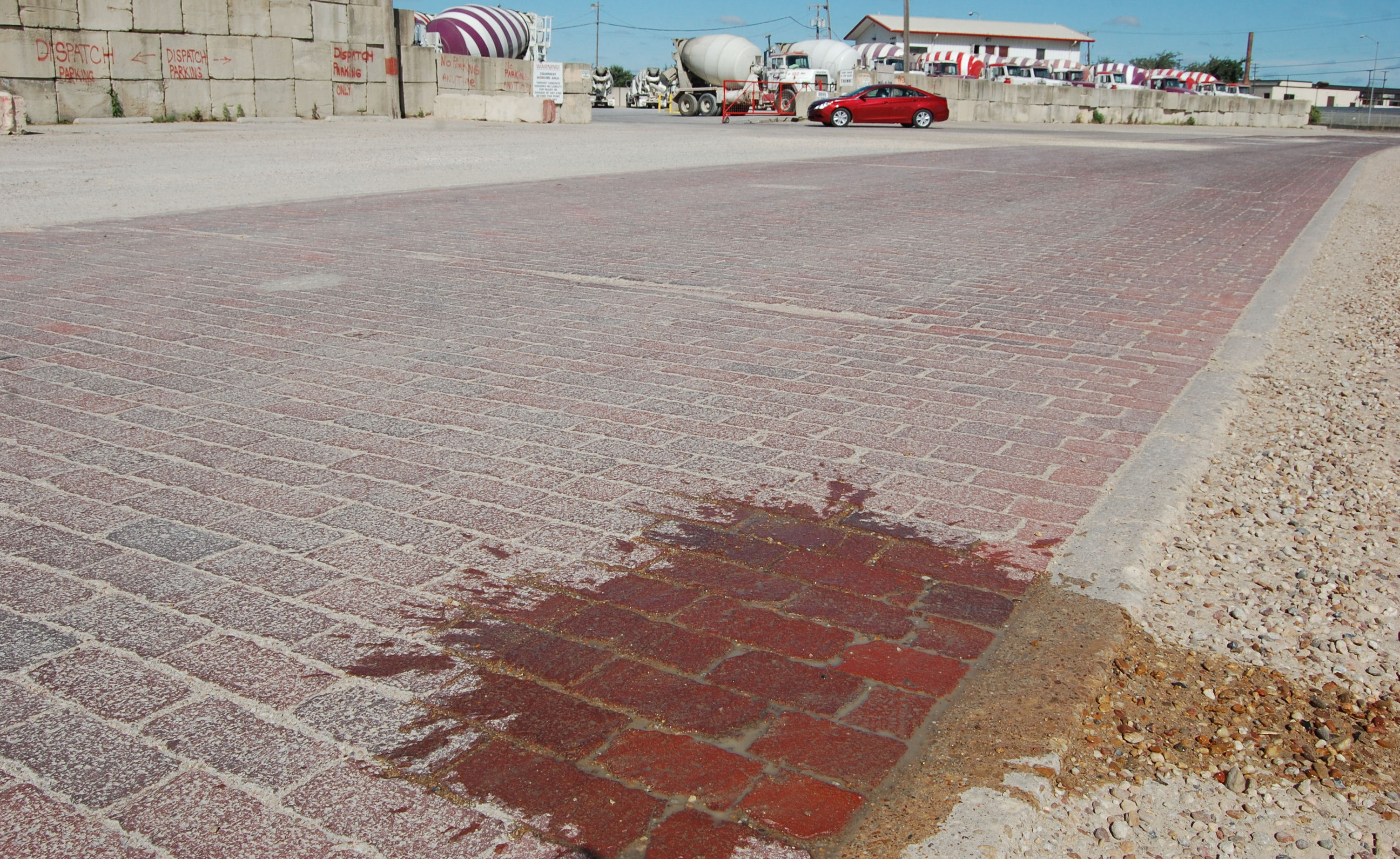 Finally, this dust-covered brick street through an industrial area just north of Interstate 20 today is named “Thelin,” but it once was the south end of Hemphill Street, the prime meridian of the South Side.
Finally, this dust-covered brick street through an industrial area just north of Interstate 20 today is named “Thelin,” but it once was the south end of Hemphill Street, the prime meridian of the South Side.

(For you geographic purists, Hemphill Street continues south from Interstate 20, with some gaps, through Crowley, ending at Alsbury Boulevard in Burleson—thirteen miles from its beginning at West Vickery.)





